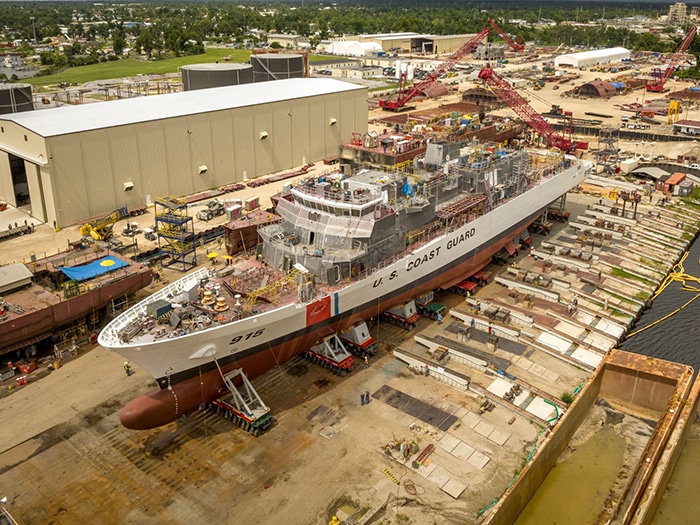
Drive shaft issue could impact delivery of OPC 1
Written by Nick Blenkey
OPC 1 under construction at Eastern Shipbuilding
In a development first reported by Forbes on Thursday, scheduled delivery of the first Offshore Patrol Cutter, Argus, from Eastern Shipbuilding in Panama City, Fla., may be affected by the discovery of problems with the main drive shafts for the first two vessels in the program.
We asked Eastern Shipbuilding Group for some clarification of the story.
“We received shafting for OPC Hulls 1 and 2 that were not in compliance with the NAVSEA requirements called for in the OPC vessel specifications. These two sets of shafting were delivered to our facility with signed and stamped certificates of approval from the American Bureau of Shipping (ABS), the U.S. Government-mandated certification authority for the OPC Program, certifying that they were in physical compliance with the ABS approved design artifacts,” said Eastern Shipbuilding Group President Joey D’Isernia. “We later discovered that both shipsets of shafting were non-compliant due to having out of tolerance physical dimensions. This issue was discovered during shaft installation on OPC Hull 1. The Coast Guard, Rolls-Royce [the supplier of the shafts] , and ABS were made aware of the problem immediately and they each had on-site representatives overseeing shaft installation. We are working closely with ABS, Rolls-Royce, and the USCG to resolve this issue as soon as possible. In the meantime, we are coordinating with the Coast Guard to advance post launch production and test activities to be completed prior to launch, in order to mitigate delivery schedule impacts and launch the ship at an even greater level of completion.”
Rolls-Royce is the supplier of the main drive shaft for hulls 1-15. The American Bureau of Shipping (ABS) is the U.S. Government-mandated certification authority for both design and construction of the OPC Program including certification of subcontractor supplied equipment (e.g., the Rolls-Royce supplied shafting).
According to Eastern, the problem was discovered during shaft installation on OPC 1 when the Port Line shaft spigot feature was unable to physically align with its associated makeup coupling. At the time, this was believed to be an isolated incident.
“It took months to discover the full scale of the problem as the OPC 1 shafts had to be removed from the ship and measured at a third-party shafting measuring facility,” says ESG. “There was no way of foreseeing this issue since the non-conformances were not visible to the naked eye and all shaft measurements were witnessed and certified by ABS before the shafting was delivered to the shipyard.”
The Coast Guard, Rolls-Royce, and ABS were aware of the problem immediately since they each had on-site representatives overseeing shaft installation, says ESG adding that, the Coast Guard, Rolls Royce, and ABS were also involved in the subsequent troubleshooting, measurements, and inspections.
ESG says that as prime contractor, it is responsible for selecting the vendor, integrating shafting into the overall ship design, material receipt and storage (shafting), and completion of installation and testing.
“We selected Rolls-Royce, the premier propulsion shafting supplier for U.S. military vessels, to design and supply NAVSEA/contract specification compliant shafts,” says the company. “ABS was responsible for approving the shaft design, witnessing inspections and measurements, and certifying the shaft’s physical conformance to the NAVSEA/contract design.’
What are the options going forward for the main drive shafts for OPCs 1 and 2?
ESG says it is working multiple, parallel paths with Rolls-Royce, the USCG, and ABS to identify suitable means to achieve compliant shafting deliveries for future hulls and to execute suitable repairs to the currently delivered shafting to NAVSEA and OEM standards.
“Our primary goal is to receive a full shipset of acceptable shafting as expeditiously as possible since this threatens to delay OPC deliveries to the USCG,” says ESG.
In the meantime, the shipbuilder is coordinating with the USCG to advance other production and test activities to mitigate ship delivery schedule impacts and launch the ship at an even greater level of completion (i.e., reducing the amount of work that must be completed between launch and ship delivery to the USCG).




